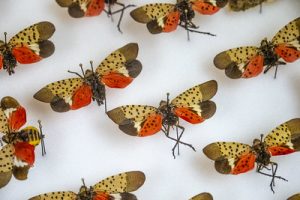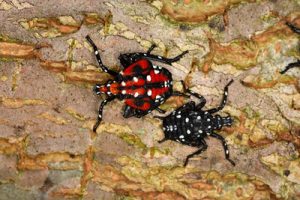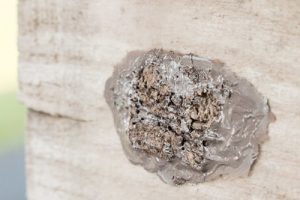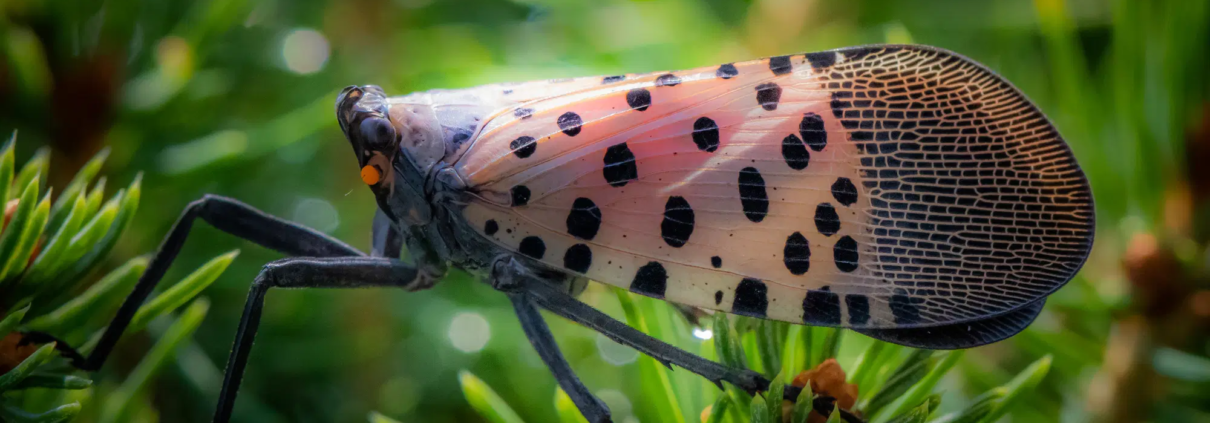Spotted Lanternfly Video: Operating Without a Permit Could Cost You $20,000
Spotted Lanternfly Video Transcription:
The spotted Lanternfly is an insect that has the ability to destroy valuable exports despite its modest size and colorful features, the spotted lanternfly is harmful to exports such as hops, grapes, tree fruit and hardwoods. It’s important to be aware of areas spotted lanternflies have been identified. What you can do avoid parking your vehicle near tree lines or under trees, keep patches, tailgates, doors, and windows shut as much as possible. Inspect clothing before entering your vehicle to help prevent the spotted Lantern fly from crawling inside. Clothing pant legs should be tucked into socks. Inspect your vehicle thoroughly for any signs of the insect. Your vehicle is a potential pathway for the spotted Lantern. Fly to hitchhike. Note when preparing for winter holidays, check outdoor items for spotted lanternfly egg masses, including those items you may bring in doors. Scrape any egg masses into a plastic zippered bag filled with hand sanitizer, then zip the bag shut and dispose of it properly.
Spotted Lanternfly Video and Information
Add another quarantine to the list of challenges to overcome. This year, the state of Pennsylvania has nearly doubled the number of counties placed under quarantine due to the spotted lanternfly. This travel quarantine applies to 28 Pennsylvania counties through which commercial vehicle operators must be permitted to travel.
placed under quarantine due to the spotted lanternfly. This travel quarantine applies to 28 Pennsylvania counties through which commercial vehicle operators must be permitted to travel.
The spotted lanternfly was first spotted in the United States in 2014 and has since rapidly expanded its U.S. population. Originating from China, India, and Vietnam, this invasive species has taken favor to many different types of fruit-bearing trees and plants on the east coast.
This year, they are back with a vengeance. Agricultural departments in Pennsylvania and New Jersey estimate 700% and 1200% increases, respectively, in the spotted lanternfly population. Projections by Penn State’s College of Agricultural Sciences show the spotted lanternfly could cause a loss of $450 million to the state’s economy and eliminate close to 5,000 jobs.
The Quarantine Measures
- Travel Restrictions: The quarantine applies to 28 Pennsylvania counties, where commercial vehicle operators must be permitted to travel.
- Enforcement: The quarantine is strictly enforced to prevent the further spread of the spotted lanternfly.
- Impact on Businesses: Businesses, especially those in agriculture and transportation, must comply with the quarantine rules to avoid penalties.
Origin and Spread
- First Sighting: The spotted lanternfly was first identified in the U.S. in 2014.
- Native Regions: This insect is native to China, India, and Vietnam.
- Preferred Hosts: It has a particular affinity for fruit-bearing trees and plants, making it a significant threat to agriculture.
Economic Impact
- Projected Losses: Penn State’s College of Agricultural Sciences projects a potential loss of $450 million to Pennsylvania’s economy.
- Job Losses: The infestation could result in the elimination of close to 5,000 jobs in the state.
- Agricultural Damage: The lanternfly’s feeding habits damage trees and plants, affecting crop yields and plant health.
Population Explosion
- Pennsylvania: The state has seen a 700% increase in the spotted lanternfly population.
- New Jersey: Neighboring New Jersey has experienced an even more staggering 1200% increase.
- Potential Spread: If not controlled, the lanternfly could spread to other states, exacerbating the economic and ecological impact.
Steps for Control
- Public Awareness: Educating the public about the spotted lanternfly and its impact is crucial.
- Monitoring and Reporting: Encouraging citizens to report sightings to help track and control the spread.
- Management Practices: Implementing effective pest management strategies, including chemical and biological controls.
- Research and Development: Supporting ongoing research to find innovative solutions to control and eradicate the pest.
Combating the Spotted Lanternfly Invasion
The spotted lanternfly represents a significant threat to the agricultural economy and ecosystem of the eastern United States. With the population exploding in Pennsylvania and New Jersey, stringent quarantine measures and effective control strategies are essential to mitigate the damage. Continued efforts in public awareness, research, and pest management will be critical in combating this invasive species and protecting the region’s economic and environmental health.
The Spotted Lanternfly
While these animals aren’t dangerous to humans, they can be devastating to a wide variety of agriculture and produce. Lanternflies are attracted to grapevines, figs, hops, avocados, and many other fruit-bearing plants. After infestation, they secrete a sweet and sticky substance that adheres to the plants. This secretion is attractive to a type of black mold that can be harmful and even cause plant death.
to grapevines, figs, hops, avocados, and many other fruit-bearing plants. After infestation, they secrete a sweet and sticky substance that adheres to the plants. This secretion is attractive to a type of black mold that can be harmful and even cause plant death.
The spotted lanternfly reproduces by laying dozens of eggs at a time. There is no population control because this species has no natural predators. Without human interference, the lanternfly population has grown exponentially.
At least 26 counties in Pennsylvania are under a strict spotted lanternfly quarantine to stop the spread of the pest. Any business that moves goods through one of the quarantined areas must be permitted to do so. Penn State Extension offers a free training course through which you can receive a permit.
The spotted lanternfly, an invasive pest originally from Asia, poses a significant threat to agriculture and ecosystems. While not harmful to humans directly, their impact on agriculture can be catastrophic. These insects are particularly drawn to fruit-bearing plants such as grapevines, figs, hops, and avocados. Once they infest these plants, they excrete a sugary, sticky substance known as honeydew, which coats the plants. This honeydew attracts sooty mold, a type of black mold that can be detrimental to plant health, potentially leading to plant death.
Key Points:
- Attraction to Fruit-Bearing Plants:
- Grape vines
- Figs
- Hops
- Avocados
- Impact on Plants:
- Secretions attract sooty mold
- Can lead to plant death
One of the major concerns with the spotted lanternfly is its rapid reproduction rate. These pests lay dozens of eggs in a single batch, and without natural predators in their non-native environments, their population has surged uncontrollably. This exponential growth has led to large-scale infestations, particularly in regions like Pennsylvania.
Reproduction and Population Control:
- Egg Laying:
- Dozens of eggs per batch
- Multiple batches per season
- Lack of Natural Predators:
- No inherent population control
- Exponential population growth
To combat the spread of the spotted lanternfly, several counties in Pennsylvania have enacted strict quarantine measures. Currently, at least 26 counties are under quarantine to prevent the pest from spreading further. Businesses operating within or passing through these quarantined areas must obtain permits, ensuring they adhere to regulations aimed at controlling the pest’s movement.
Quarantine Measures:
- Affected Counties:
- At least 26 counties in Pennsylvania
- Business Compliance:
- Permits required for moving goods through quarantined areas
- Free training and permit issuance by Penn State Extension
Moreover, Penn State Extension offers a free training course that educates businesses and individuals on how to handle the spotted lanternfly and comply with quarantine regulations. This initiative aims to equip people with the knowledge and tools necessary to mitigate the spread of this invasive species effectively.
Actions for Businesses and Individuals:
- Training and Permits:
- Free training course by Penn State Extension
- Permit issuance for compliance
Managing the Threat of the Spotted Lanternfly
The spotted lanternfly, while not a direct threat to human health, poses a significant risk to agriculture and ecosystems due to its rapid reproduction, lack of natural predators, and the harmful effects of its secretions. Strict quarantine measures and educational initiatives are critical in managing and controlling the spread of this invasive pest. By understanding the risks and taking appropriate actions, it is possible to mitigate the impact of the spotted lanternfly on agriculture and the environment.
Manager’s Responsibility
At least one person in your company must complete the course and pass the knowledge along to the rest of the fleet. Any company that operates out of compliance could face a civil penalty of up to $20,000. The free Spotted Lanternfly course is available and teaches:
- The importance of stopping spotted lanternfly
- Lifecycle and habits of SLF
- How quarantine zones work
- Find and destroy SLF
- Quarantine zone best practices
Each unit of your fleet who moves through one of the quarantined zones must be properly trained and carry a permit. Through the Infinit-I Workforce Solutions platform, you can assign custom training to all your drivers and issue their permits. Drivers can access that permit at any time through their resource library, should they be asked to provide it to enforcement officers.
Trucker’s Responsibility
Especially when crossing state or county lines, truck drivers should take special action to ensure they are not contributing to the spread of the insect. Instruct your drivers to complete a thorough search for spotted lanternfly nests on their equipment during their pre- and post-trip inspection.
Infinit-I Workforce Solutions offers comprehensive training content on how to manage spotted lanternfly occurrences. Current clients already have access to these materials and it’s ready to “plug and play” with their current training system.
Lanternfly resources and topics we cover:
- Destroying Spotted Lanternfly Egg Masses
- Development Stages of the Spotted Lanternfly
- How to Comply with Spotted Lanternfly Regulations Fact Sheet
- How to Identify and Destroy Spotted Lanternfly Egg Masses
- If You See A Spotted Lanternfly, Report It!
- Lanternfly Quarantine Zone Map
- Spotted Lanternfly Permit Training (Parts 1-5)
- Spotted Lanternfly Training Quiz
 The US Department of Agriculture recommends destroying spotted lanternfly egg masses if found. Spotted lanternflies make nests on hard surfaces, your drivers should thoroughly check their wheel wells, bumpers, and in/around trailers. The nests, which can resemble tree bark, can be removed easily with any tool with a rigid surface. Scrape the egg mass into a plastic bag filled with rubbing alcohol or hand sanitizer to eliminate the offspring.
The US Department of Agriculture recommends destroying spotted lanternfly egg masses if found. Spotted lanternflies make nests on hard surfaces, your drivers should thoroughly check their wheel wells, bumpers, and in/around trailers. The nests, which can resemble tree bark, can be removed easily with any tool with a rigid surface. Scrape the egg mass into a plastic bag filled with rubbing alcohol or hand sanitizer to eliminate the offspring.
We Can Help!
Remember, the state of Pennsylvania requires fleets to carry permits with them throughout the quarantined areas after proper training. We must do our part to suppress the expansion of the spotted lanternfly population.
For Current Infinit-I Workforce Solutions Clients:
Contact your Client Success Rep today to become spotted lanternfly certified and receive your fleet’s permits. Our content catalog has all the training you need to become a certified spotted lanternfly trained fleet.
For Future Infinit-I Workforce Solutions Clients:
Receive your spotted lanternfly training and certification today for free! We are offering a 30-day complimentary trial, no obligation. We can help you choose your designated spotted lanternfly trainer and have you certified by end of business today.
Get a free demo for more information about how to receive your fleets certification and permits.
FAQs
What is a spotted lanternfly?
The spotted lanternfly is an invasive pest originally from Asia, particularly harmful to agriculture and ecosystems by infesting fruit-bearing plants.
Why is the spotted lanternfly a concern for trucking companies?
The spotted lanternfly can spread through vehicles, and there are strict quarantine measures in place to prevent this. Trucking companies must comply with these regulations to avoid penalties.
Which states are currently affected by the spotted lanternfly?
Pennsylvania and New Jersey are significantly affected, with 28 counties in Pennsylvania under quarantine.
What are the quarantine measures for the spotted lanternfly in Pennsylvania?
Businesses, especially those in agriculture and transportation, must obtain permits to move goods through quarantined areas and comply with specific quarantine rules.
How does the spotted lanternfly impact agriculture?
The lanternfly feeds on fruit-bearing plants, secreting a sticky substance that attracts harmful mold, which can damage or kill the plants.
What are the economic impacts of the spotted lanternfly?
The infestation could cause a loss of $450 million to Pennsylvania’s economy and eliminate nearly 5,000 jobs.
How can trucking companies prevent the spread of the spotted lanternfly?
Drivers should conduct thorough inspections for lanternfly nests on their equipment during pre- and post-trip inspections and comply with quarantine regulations.
What should drivers look for during inspections?
Drivers should search for egg masses that resemble tree bark on hard surfaces such as wheel wells, bumpers, and around trailers.
How can spotted lanternfly egg masses be destroyed?
Egg masses can be scraped into a plastic bag filled with rubbing alcohol or hand sanitizer to eliminate the offspring.
Is there any training available for handling spotted lanternfly?
Yes, Penn State Extension offers a free training course on spotting, reporting, and managing the spotted lanternfly, as well as complying with quarantine measures.
What are the penalties for non-compliance with quarantine measures?
Companies could face a civil penalty of up to $20,000 for operating out of compliance with the spotted lanternfly quarantine regulations.
What is required for a company to comply with quarantine regulations?
At least one person in the company must complete the training course and pass the knowledge to the rest of the fleet. Permits must be carried by all drivers moving through quarantined zones.
How can Infinit-I Workforce Solutions help with spotted lanternfly training?
Infinit-I Workforce Solutions provides comprehensive training content on managing spotted lanternfly occurrences and helps companies become certified.
What resources are available from Infinit-I Workforce Solutions for spotted lanternfly management?
Resources include training on destroying egg masses, understanding development stages, complying with regulations, and more.
How can businesses get certified for spotted lanternfly management?
Contact Pen State Extension for all training and permits. Infinit-I also offers video training on this topic.
What should truck drivers do if they see a spotted lanternfly?
Drivers should report sightings immediately and follow procedures to control and prevent the spread, as per the training provided by their company.













